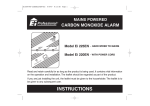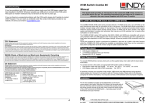Download Andy Simmonds - Disability Essex
Transcript
Two linked Passivahaus certified buildings -The Centre for Disability Studies “Cool, all energy efficiency and no Bling.....” “..OK, yes, I suppose we could call the MVHR frost protection system a „ground source heat pump‟ ..if you need to...” Impact of Energy Performance Standards on NonDomestic Building Energy Use RELATIVE ENERGY CONSUMPTION 2 Delivered energy in units of kWh/m yr 300 250 Average for types 1, 2, 3 & 4 Office elec equipment Ventn. & other HVAC Lighting 200 Water heating Space heating 150 100 50 0 Typical UK office Typical UK BRE Env. Bldg. Eliz. Fry Bldg. Lamparter Office Waldshut School secondary school 1999 1996-97 2000 2004-05 Impact of Energy Performance Standards on Non-Domestic Building CO2 Emissions RELATIVE CO2 EMISSIONS 2 In units of kg/m yr 90 Elec office equipment 80 70 Ventn. & other HVAC Average for types 1, 2, 3 & 4 Lighting 60 Water heating 50 Space heating 40 30 20 10 0 Typical UK office Typical UK BRE Env. Bldg. Eliz. Fry Bldg. Lamparter Office Waldshut School secondary school 1999 1996-97 2000 2004-05 1. Heat demand ≤ 15 kWh/m²year [15 Wing A and 14 Wing B] 2. Airtightness: n50-value ≤ 0,6 h-1 [Wing A&B = each 0.3] 3. Overheating ratio ≤ 10% year above 25°C [Wing A&B = 6%] 4. Primary energy ≤ 120 kWh/m²year [Wing A=90*, Wing B = 117*] * Dependent on adoption of Design Team’s recomendations for e.e. IT & office equipment and any domestic appliances (over time?). Seperate report to client. Construction THERMAL MASS: WELL DISTRIBUTED THERMALLY MASSIVE ELEMENTS: CONCRETE & GYPSUM/CELLULOSE BOARDS Thermal bridge free construction ≤ 0.1 W/mK [rule of thumb, c. 200mm insulation uninterupted around a junction 80% reductions – OK for some...... Grove Cottage. Designed and performing at Passivhaus „Enerphit‟ levels. A low energy Hi-Comfort house 39 6 .1 5 BE HA LL 1 FOUNDATIONS WALL – inner leaf Thermal bridge free construction Reduce the timber fraction ROOF – timber structure ROOF – layers Roof – layers ctd Thermal bridge free construction Relies on thermal integrity too – no gaps in your insulation! ROOF – insulation and airtightness measures WALL – Larsen truss type WALL – Larsen truss type AIRTIGHTNESS: PLASTER, CONCRETE & TAPED MEMBRANE TIMBER – internal structural frame, windows and first airtightness measures ROOF –airtightness measures WALL – external insulation, rendered Bitumino us coating directly to top face EPS cill pieces by Pe rmaro ck As the doors are recessed, the frame is shielded from the cold night sky and therefore appears warmer. No issues. DRIP C This shows the 'warmer' parts of the window, however, these are due to shielding from the sky and not considered heat losses. THERMAGRAPHIC SURVEY – infrared view Building services • Heating • Ventilation • Hot and cold water • Lighting • Heating – Gas boiler and radiators – Oversized radiators for low temperature – Weather compensation for control and efficiency – Thermostatic radiator valves for user control – Straightforward technology – not expensive • Ventilation – Mechanical heat recovery ventilation – Airtight building needs fresh air ventilation system – Heat recovery needed for passivhaus energy level – Exposed ductwork – 3 MVHR units for simple zoning: 1. Wing A 2. Training room 3. Wing B • Hot and cold water – Gas boiler and solar thermal collector – Highly insulated cylinder – Microbore distribution – Low water use taps – 4 litre syphon flush WCs – Waterless urinals • Lighting – Design for daylight – modelled in lighting program – Light, high reflectance internal surfaces – Electric lighting designed for 300 lux – Efficient high light output fittings and T5 tubes – 5.9 W/m² for internal lighting (+0.3 W/m² external) – Daylight dimming in communal areas Daylight dimming in large rooms Integrated daylight and electric lighting design • Heating / ventilation interlock – Problem: the vent system can provide fresh air cooling at the same time as the heating is on • Sunny winter day fresh air cooling • Cold air in through vents turn the heating up • Even more cold air in... Result: discomfort + high energy consumption • Solution: one overall controller – This provided by ventilation controls – designed for duct heater, but here controls radiator zone valve • Winter – vent controls set to “heating on” - won’t provide fresh air cooling (summer bypass) • Summer – manual switch to “heating off” – ventilation bypasses heat recovery when warm The outakes - bits that didn’t go quite right The outakes - bits that didn’t go quite right • Problems in use – Drying out – the heating energy needed to dry out a just-completed wet plastered masonry structure is far more than Passivhaus heat loss – High electrical use – by tennants’ IT and office equipment • MVHR is NOT air conditioning – Daily swing 1.5-2C, but temp creeps up each day – Without night cooling this building can overheat Office 1 room temperature 30 29 28 27 26 25 24 23 22 21 20 22/05/2010 00:00 27/05/2010 00:00 01/06/2010 00:00 06/06/2010 00:00 11/06/2010 00:00 16/06/2010 00:00 21/06/2010 00:00 26/06/2010 00:00 01/07/2010 00:00 06/07/2010 00:00 • What about next time? – Radiators again – that was easy! – Simpler boiler controls – Combi hot water – don’t use much at all – Simpler vent controls – and CO2 speed control – No daylight dimming of lighting – just auto-off – ALL south windows shaded – Write user manual BEFORE users move in Passivhaus Institut RfF Competition http://tinyurl.com/36h3fv6 AECB/TSB low energy buildings database http://www.retrofitforthefuture.org/ ‘Less is More – secure energy after oil’ Less Is More? AECB report - in preparation (working with CAT to explore further issues raised in Zero Carbon Britain) • A sustainable and secure energy future after oil - using less energy, more productively. • Climate change policy. What must we do to return atmospheric CO2 levels to 350 ppm and safeguard world climate? • The UK has had its peak coal, oil and gas. What next? • How do the costs of different future energy systems, including energy efficiency, compare to fossil fuels (a bench mark for the economics of the energy transition)? • The coming age of scarcity; why we must arguably plan for an absolute decline in energy availability. • Increased energy productivity; what has the UK achieved, what must it achieve? Thermodynamic realities. • Changes needed to UK energy policy to deliver a sustainable and affordable energy system. Energy Economics: The High Costs of Future Energy Supply 10000 £/delivered kW ENERGY WHOLE SYSTEM COSTS 1 Persian gulf oil 2 Middle Easterfn gas 3 Solar DH, seasonal storage 4 Nuclear fission electricity 5 Tidal double lagoon elec 6 Offshore wind elec 7 CFLs replace incandescent 8 Condensing boilers replace typical one 9 A++ fridge replaces typical one 10 A+ washing machine replaces typical one 11 LCD TV replaces typical one 12 250 mm wall insulatoon, new building 13 Passivhaus windows 14 Retrofit solid wall external insulation Lovins 1976 for oil & gas, updated for inflation, author's calculations for other technologies using Tidal Electric data for Swansea double lagoon, Sizewell B actual costs for nuclear, load factors of 0.33 wind, 0.65 nuclear, 0.36 tidal, peak T&D losses 11%, marginal grid reinforcement cost £1000/kW. 9000 £/kW & £/NegaWatt 8000 NUCLEAR AND RENEWABLES 7000 6000 5000 4000 3000 2000 FOSSIL FUELS ENERGY EFFICIENCY IMPROVEMENTS 1000 0 1 2 3 4 5 6 7 8 9 10 11 12 13 14 SOME EXPECTATION MANAGEMENT Do we really appreciate: 1. How easy and cheap it has been to industrialise using such accessible, high grade, powerfully energy rich fuel sources, such as wood, coal, gas and oil? 2. The dangers of „obsessing on supply side‟ thinking: i.e., that we appear to be up against the laws of physics by hoping that we can maintain our existing type of growth economy mainly by replacing cheap energy rich fossil fuels with renewable energy supply technologies, which can‟t deliver anywhere near the same amount of power per unit of Gross Domestic Product as fossil fuels have done? 3. The realities of nuclear fission „saving the day‟ (?) – as globally limited by uranium suppliy? Energy Economics: The High Costs of Future Energy Supply 10000 £/delivered kW ENERGY WHOLE SYSTEM COSTS 1 Persian gulf oil 2 Middle Easterfn gas 3 Solar DH, seasonal storage 4 Nuclear fission electricity 5 Tidal double lagoon elec 6 Offshore wind elec 7 CFLs replace incandescent 8 Condensing boilers replace typical one 9 A++ fridge replaces typical one 10 A+ washing machine replaces typical one 11 LCD TV replaces typical one 12 250 mm wall insulatoon, new building 13 Passivhaus windows 14 Retrofit solid wall external insulation Lovins 1976 for oil & gas, updated for inflation, author's calculations for other technologies using Tidal Electric data for Swansea double lagoon, Sizewell B actual costs for nuclear, load factors of 0.33 wind, 0.65 nuclear, 0.36 tidal, peak T&D losses 11%, marginal grid reinforcement cost £1000/kW. 9000 8000 NUCLEAR AND RENEWABLES 7000 6000 5000 4000 3000 2000 FOSSIL FUELS ENERGY EFFICIENCY IMPROVEMENTS 1000 0 1 2 3 4 5 6 7 8 9 10 11 12 13 14 “No man is an island” (women know this already) John Donne (1572-1631) 1. 2. 3. The autonomous householder? Community level solutions? We will do our bit, the government needs to do their bit – what is that? What exactly is the challenge .... We are working in the absence of an integrated UK energy policy We realise that for most countries decisions on how they heat and power their existing building stock is pivotal for achieving energy security, social cohesion and climate change mitigation and adaptation. • Denmark has an integrated vision and it seems credible that they can phase out fossil fuels by 2030 – UK vision is currently far less credible.... Is PH for each new building the right target - are there cheaper communal, off site solutions? Yes, but we need ‘serious slack’ for the far more difficult Refurbishment Challenge.... If you don‟t quite reach PH but have used the PH approach, you can certify as AECB Silver - still an advanced low energy building likley to perform well in the real world... Grove Cottage . A low energy refurbishment Simmonds.Mills Architects Cost of Some Measures Analysed £ per tonne CO2 equiv. 1-11 Fabric 12-14 Services including heat main 15-20 Elec. appliances and lighting This project aiming to apply measures for less than £40/tonne CO2, achieved 80% CO2 savings, but did not get RfF funding. Potential Ways Forward • Unlike new supply, many energy efficiency measures studied to date compete with the resource cost of oil, let alone the market price of oil. Opportunities are being missed. • Lavish, but selective, investment in energy efficiency could keep annual costs at acceptable levels, despite the rise in energy supply costs per kWh. • We need to give energy efficiency priority over more costly options, otherwise we shall face great economic difficulties.. Drop incentives for (?): •Individual air source electric heat pumps •Gas micro CHP •Micro-wind on roofs - largely discredited •Solar thermal on small house roofs - never pays back versus mains gas cond. boiler. •Biomass boilers on UK wide scale - appear a good way to make climate change worse and reverse years of important public health improvements - many more valuable uses for a limited fuel. •Burning biomass in power stations More support for solid, sound, proven measures Energy efficiency •Insulation beyond Bldg Regs - or better still make the regulations AECB Silver moving to Passivhaus in time •Retrofit insulation where cost-effective against the heat supply method •Draughtproofing (new UK construction worse than pre-War Swiss, German and Swedish buildings - failure to issue guidance to industry on how the continental countries make buildings so tight) •Gas (and biomethane) CHP •MEV (all one needs in buildings which are heated by waste heat) •MVHR (in buildings heated by unavoidably expensive heat sources) Cheap renewables •Passive solar heat (see the Canadian graph) •Daylighting •District-scale solar thermal (can crane into place, costs 20-25% as much per kWh and UK can meet decent renewable heat targets quickly) •Geothermal (Southampton built its geothermal system without government help, £4M at today‟s prices, most wells have a better yield - many UK aquifers should be investigated and exploited if possible; e.g. Bath, Worcester/Droitwich, Belfast/Larne, Hartlepool/Teesside, Scotland Central Belt, etc.) small hydro occasionally, just maybe, PV. occasionally, individual ground source electric heat pumps. – outside gas supply area very large ones electric ground source heat pumps on DH systems Solar thermal worth considering off gas grid if combined with oil / LPG condensing boilers, solar backed up by stored fuel gives lower CO2 emissions (kg/ kWh heat) than a ground source heat pump. The Refurbishment challenge is daunting – more so if we judge ourselves by measured performance.....New build must be reliably very low energy fabric, resource efficient, future proofed against fuel transitions Generally We need to remember to use high grade energy for high grade uses (don’t heat with electricity) •The public can do their bit (insulation even to half this) •But DECC have to do theirs: • low carbon heat supply • Financial incentives for energy efficiency What might the ‘communal approach’ look like?













































































